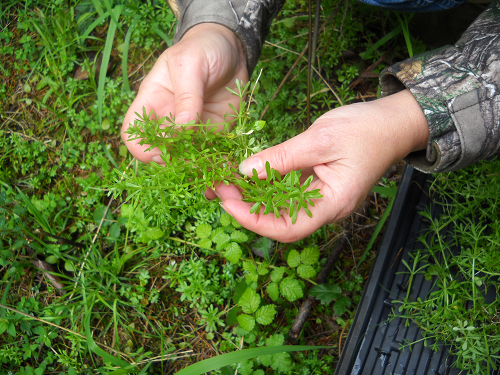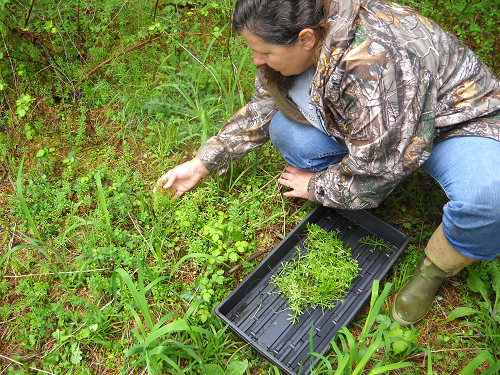 Loading... Please wait...
Loading... Please wait...Cleavers, The Herb that Sticks to you
Posted by Patricia Delgado on 23rd Apr 2015
In keeping with my foraging theme, its cleavers season in Elbe, Washington and our farmstead has a bountiful harvest in the back forty. Cleavers (Galium aparine) is a common lawn weed. It tends to grow in shady, moist corners and is
most well-known for its ability to cling to clothing and hair. I remember
playing with this weed when I was a little girl in
Cleavers are a seasonal plant – really only appearing for about a month every spring and appearing in unlikely places – yards, edges of roads, and edges of wooded areas. They’re easy to spot because there’s a bare green stem with a whirl of 6 leaves, then bare green stem, then another whirl. It’s not an easy plant to confuse with anything else and so it’s a great plant if you’re new to foraging and don’t want to risk anything toxic – probably a good idea, right? If it’s distinctive looks weren't enough, cleavers has one other unique characteristic that makes it hard to confuse with anything else, and that is the reason it got it’s name. Cleavers are covered with tiny barbs – they’re soft and not prickly, but it will happily stick to your clothing and hair. It’s a great test to make sure you've got the right plant.
Cleavers is one of the early spring herbs which were traditionally used as spring tonics. It is considered by many herbalists to be a superb herb for toning and nourishing the lymphatic system, as well as being a mild diuretic. It is high in vitamin C which may be one reason it was valued as a spring tonic herb, in addition to its lymph cleansing properties. In terms of flavor, Cleavers tastes very much like spring – it’s a fresh, green sort of flavor. If your going to eat Cleavers raw is best when you mix it with salad greens. I think it would be too much on its own and probably too much for your body as well – in part because cleavers, or Galium aparine is strongly medicinal.
Medicinal Uses of Cleavers, or Galium aparine has been used historically for a wide variety of ailments and is as a cleanser for the blood and lymphatic system. Just like spring is a great time to do a deep clean, purging all of the unwanted junk that piles up over the winter, it’s also a great time to clean out your own system. Galium, which appears naturally at just this time, can be a great addition to that protocol. This can be as simple as eating 1-2 stems raw and fresh (the little barbs on the plant have an interesting feel inside the mouth) or you can dry some of the herb and continue to use it year round in teas. As part of the cleansing process you will notice it also has a mild diuretic effect, and will increase the amount you have to use the restroom.
This blood and lymph cleansing effect can help with swollen glands, skin rashes and eruptions, liver, kidney and urinary disorders and to boost overall energy and vitality when combined with a general detoxification protocol. Again – spring cleaning can be a great thing for your whole body. Cleavers may be such an effective blood cleanser simply because it is a potent antioxidant, and potent free radical scavenging powers have been demonstrated in research of the aqueous extract. Good thing because the aqueous, or water extract, is the easiest one to make at home in the form of a tea.
 Cleavers as an anti-tumor and anti-cancer agent: Galium
species are a new target for research as anti-cancer agents. This includes
cleavers (Galium aparine) and it’s cousin lady’s bedstraw (Galium verum). Galium aqueous extract (this is a fansy word for herbal tea)
shows strong cytotoxic effects on various tumor lines including Hep2 and HLaC79
cell lines – these are two aggressive head and neck cancers. It has also been
studied with success in cervical, breast, prostate and bladder cancer.
Cleavers as an anti-tumor and anti-cancer agent: Galium
species are a new target for research as anti-cancer agents. This includes
cleavers (Galium aparine) and it’s cousin lady’s bedstraw (Galium verum). Galium aqueous extract (this is a fansy word for herbal tea)
shows strong cytotoxic effects on various tumor lines including Hep2 and HLaC79
cell lines – these are two aggressive head and neck cancers. It has also been
studied with success in cervical, breast, prostate and bladder cancer.
Historically, cleavers is one ingredient in the famously controversial herbal anti-cancer formula called Hoxsey formula. There are various ways of preparing this formula, but one of the safer and less controversial versions can be found on my website under Herbal Remedies.
Cleavers as a topical: Cleavers tea has also been used as a topical wash for burns, skin rashes, skin eruptions, and generally irritated skin. Historically it was mashed into a pulp and applied to bites and stings. Research has shown that water extract of cleavers have anti-b acterial, anti-fungal and anti-inflammatory effects so no wonder it’s good for your skin.
Cleavers are a nice addition to your spring diet and can be eaten raw, added to salads, cooked up with a variety of other pot greens like spinach, kale, chard or collards or dried for use in herbal teas. A true gift from God and its free!
A few Remedies below:
This formula can be mixed in large batches and brewed as a concentrate (like the similar anti-cancer formula which is available retail called Flor-Essence) or mixed dry and brewed in small batches. To make a cup of tea use 1 tablespoon of the mixed dry herb and simmer in a cup of boiling water for about 10 minutes. As a starter anti-cancer cleanse Hoxsey suggested having a half cup of tea every 1-2 hours for a week.
Hoxsey-like formula: 1 oz Red clover, 1 oz Burdock, 1 oz Dandelion root, 1 oz Sarsaparilla, 1 oz Oregon grape, 1 oz Cleavers, 1 oz Buckthorn, 1 oz Poke, 1 oz Echinacea, 1 oz Licorice, 1 oz Ginger, and 1 oz Wild yam
Although the cancer research we have now is insufficient to say whether or not this would be an effective protocol for any particular cancer by itself, it would certainly be a good addition to an already existing cancer protocol and could potentially be used in conjunction with other cancer therapies such as radiation. If you are using chemotherapy talk with your MD or oncologist about any herbs before adding them, simply because we genuinely don’t know how those therapies will interact.
Cleavers Green Juice - Making a juice with cleavers is very easy and also the most potent as you will be ingesting the life blood of the plant. It does require using a juicer but if you don’t have one you could put it in your little bullet blender with some water and then strain. I take a big handful of cleavers and add some apple, fennel, lemon, ginger and celery and blend them all together. This makes a delicious cleansing and revitalizing drink.
Cleavers Vinegar - Lightly pack a mason jar with cleavers then cover them with unpasteurized apple cider vinegar. Put a plastic cap lid on it and allow to infuse for three weeks before straining and re-bottling. This makes a great salad dressing with a drizzle of olive oil.
Cleavers Cold Infusion - Many people prepare their cleavers as a cold infusion by popping a handful in a glass, covering in cold water and leaving overnight to infuse. Strain and drink in the morning for a refreshing start to the day.
This is about it for this weeks foraging, I will squeak at you next week with a new entry.
In every situation please talk with your doctor and health care team before starting a new therapy, especially for something as serious as cancer.


